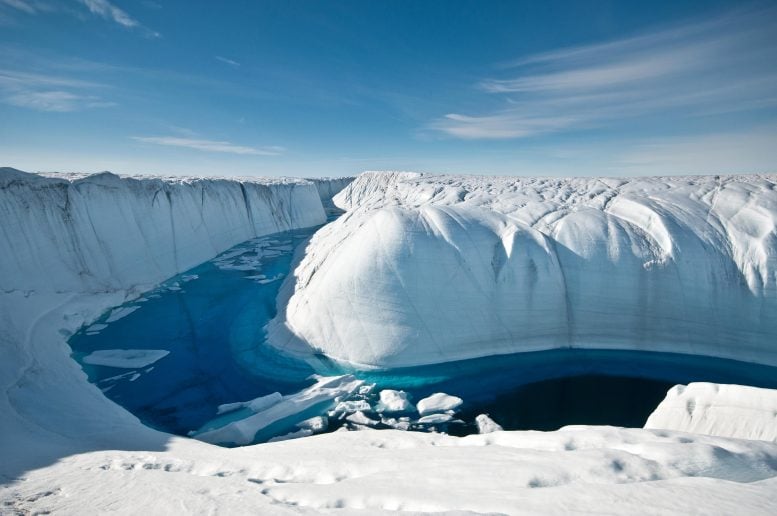The rate of global ice loss is speeding up, according to new research.
And the findings also reveal that the Earth lost 28 trillion tonnes of ice between 1994 and 2017 – equivalent to a sheet of ice 100 meters thick covering the whole of the UK.
The figures have been published today (Monday, January 25, 2021) by a research team which is the first to carry out a survey of global ice loss using satellite data.
The team, led by the University of Leeds, found that the rate of ice loss from the Earth has increased markedly within the past three decades, from 0.8 trillion tons per year in the 1990s to 1.3 trillion tons per year by 2017.
Ice melt across the globe raises sea levels, increases the risk of flooding to coastal communities, and threatens to wipe out natural habitats which wildlife depend on.
The findings of the research team, which includes the University of Edinburgh, University College London, and data science specialists Earthwave, are published in the European Geosciences Union’s journal The Cryosphere.
The research, funded by the UK Natural Environment Research Council, shows that overall, there has been a 65 % increase in the rate of ice loss over the 23-year survey. This has been mainly driven by steep rises in losses from the polar ice sheets in Antarctica and Greenland.
Lead author Dr. Thomas Slater, a Research Fellow at Leeds’ Centre for Polar Observation and Modelling, said: “Although every region we studied lost ice, losses from the Antarctic and Greenland ice sheets have accelerated the most.
“The ice sheets are now following the worst-case climate warming scenarios set out by the Intergovernmental Panel on Climate Change. Sea-level rise on this scale will have very serious impacts on coastal communities this century.”
Dr. Slater said the study was the first of its kind to examine all the ice that is disappearing on Earth, using satellite observations.
He added: “Over the past three decades there’s been a huge international effort to understand what’s happening to individual components in Earth’s ice system, revolutionized by satellites which allow us to routinely monitor the vast and inhospitable regions where ice can be found.
“Our study is the first to combine these efforts and look at all the ice that is being lost from the entire planet.”
The increase in ice loss has been triggered by warming of the atmosphere and oceans, which have warmed by 0.26°C (0.47°F) and 0.12°C (0.22°F) per decade since 1980, respectively. The majority of all ice loss was driven by atmospheric melting (68 %), with the remaining losses (32%) being driven by oceanic melting.
The survey covers 215,000 mountain glaciers spread around the planet, the polar ice sheets in Greenland and Antarctica, the ice shelves floating around Antarctica, and sea ice drifting in the Arctic and Southern Oceans.
Rising atmospheric temperatures have been the main driver of the decline in Arctic sea ice and mountain glaciers across the globe, while rising ocean temperatures have increased the melting of the Antarctic ice sheet. For the Greenland ice sheet and Antarctic ice shelves, ice losses have been triggered by a combination of rising ocean and atmospheric temperatures.
During the survey period, every category lost ice, but the biggest losses were from Arctic Sea ice (7.6 trillion tons) and Antarctic ice shelves (6.5 trillion tons), both of which float on the polar oceans.
Dr. Isobel Lawrence, a Research Fellow at Leeds’ Centre for Polar Observation and Modelling, said: “Sea ice loss doesn’t contribute directly to sea level rise but it does have an indirect influence. One of the key roles of Arctic sea ice is to reflect solar radiation back into space which helps keep the Arctic cool.
“As the sea ice shrinks, more solar energy is being absorbed by the oceans and atmosphere, causing the Arctic to warm faster than anywhere else on the planet.
“Not only is this speeding up sea ice melt, it’s also exacerbating the melting of glaciers and ice sheets which causes sea levels to rise.”
Half of all losses were from ice on land – including 6.1 trillion tons from mountain glaciers, 3.8 trillion tons from the Greenland ice sheet, and 2.5 trillion tons from the Antarctic ice sheet. These losses have raised global sea levels by 35 millimeters.
It is estimated that for every centimeter of sea level rise, approximately a million people are in danger of being displaced from low-lying homelands.
Despite storing only 1 % of the Earth’s total ice volume, glaciers have contributed to almost a quarter of the global ice losses over the study period, with all glacier regions around the world losing ice.
Report co-author and PhD researcher Inès Otosaka, also from Leeds’ Centre for Polar Observation and Modelling, said: “As well as contributing to global mean sea level rise, mountain glaciers are also critical as a freshwater resource for local communities.
“The retreat of glaciers around the world is therefore of crucial importance at both local and global scales.”
Just over half (58 %) of the ice loss was from the northern hemisphere, and the remainder (42 %) was from the southern hemisphere.
Reference: “Earth’s ice imbalance” by Thomas Slater, Isobel R. Lawrence, Inès N. Otosaka, Andrew Shepherd, Noel Gourmelen, Livia Jakob, Paul Tepes, Lin Gilbert and Peter Nienow, 25 January 2021, The Cryosphere.
DOI: 10.5194/tc-15-233-2021
Funding: UK Natural Environment Research Council










“One of the key roles of Arctic sea ice is to reflect solar radiation back into space which helps keep the Arctic cool.”
In order for light to be scattered in water from suspended sediment and plankton, it has to penetrate into the water. One reason that Arctic water looks dark is that it generally has high reflectivity; therefore, much less light enters than at low latitudes. Additionally, in contrast to the diffuse reflectance of snow, the low sun angle and specular (mirror-like) reflectance of water means that it can have high reflectivity and still look dark unless one is looking in the direction of the sun over the horizon — not unlike driving into the setting sun on wet pavement!
The reflectivity of Arctic water is very sensitive to the angle of incidence of sunlight, actually reaching 100% at the terminator, when the sun is sitting on the horizon. The polar regions are geographically unique and when I keep reading things like the claims in this article I’m reminded of a definition of a PhD: Someone, who as they become specialists, knows more and more about less and less.
https://wattsupwiththat.com/2016/09/12/why-albedo-is-the-wrong-measure-of-reflectivity-for-modeling-climate/
The article states, “… there has been a 65 % increase in the rate of ice loss over the 23-year survey. This has been mainly driven by steep rises in losses from the polar ice sheets in Antarctica and Greenland.”
The following article claims that there has been no warming in Antarctica in the last 7 decades: https://www.nature.com/articles/s41612-020-00143-w
Is ‘scitechdaily’ being selective in what it reports on?
Wow, what brilliant insight, Clyde. I’m sure none of the climate scientists have considered this basic aspect of physics that you, as a layperson climate-denier have brought up. Note that during the Arctic and Antarctic summers, when sea ice extent is least is when the sun shines down most directly AND that the sun doesn’t set for days, weeks, or months (depending on your proximity to the poles).
For starters, I’m not a “layperson.” And, I do not deny that climate exists.
The sun rises over the Arctic Circle after the NH Winter Solstice; that is the position of the terminator, where the specular reflection reaches 100% on the water. The terminator moves poleward until the Vernal equinox, when the terminator goes through the North Pole. Three months later, during the NH Summer Solstice, the sun moves between 0 degrees and about 47 degrees elevation above the horizon on the Arctic Circle, and reaches a maximum elevation of about 23.5 degrees at the North Pole. Your “most directly”– mid-day — is about the same as between sunrise and 8:00 AM at the Equator during the Equinox. Yes, there is some illumination above the Arctic circle for 6 months out of the year. More importantly, the sun’s position in the sky in the Arctic is not constant, but instead the angle of incidence in daylight hours is when the reflectivity is varying most rapidly between about 3% and 100%. It is not constant for every place within the Arctic Circle.
Extensive reading on the topic of warming in the Arctic has left me with the impression that none of the climatologists writing about the Arctic are familiar with Fresnel’s equation on specular reflection. Do you have anything to offer other than insults? Personal attacks are usually taken to indicate that the person has no substantive arguments.
Increasing magma,decrease ice
Ice age follows after enough volcanism is unleashed
Trying to control CO2 won’t stop the melt. This of coarse is just my opinion.